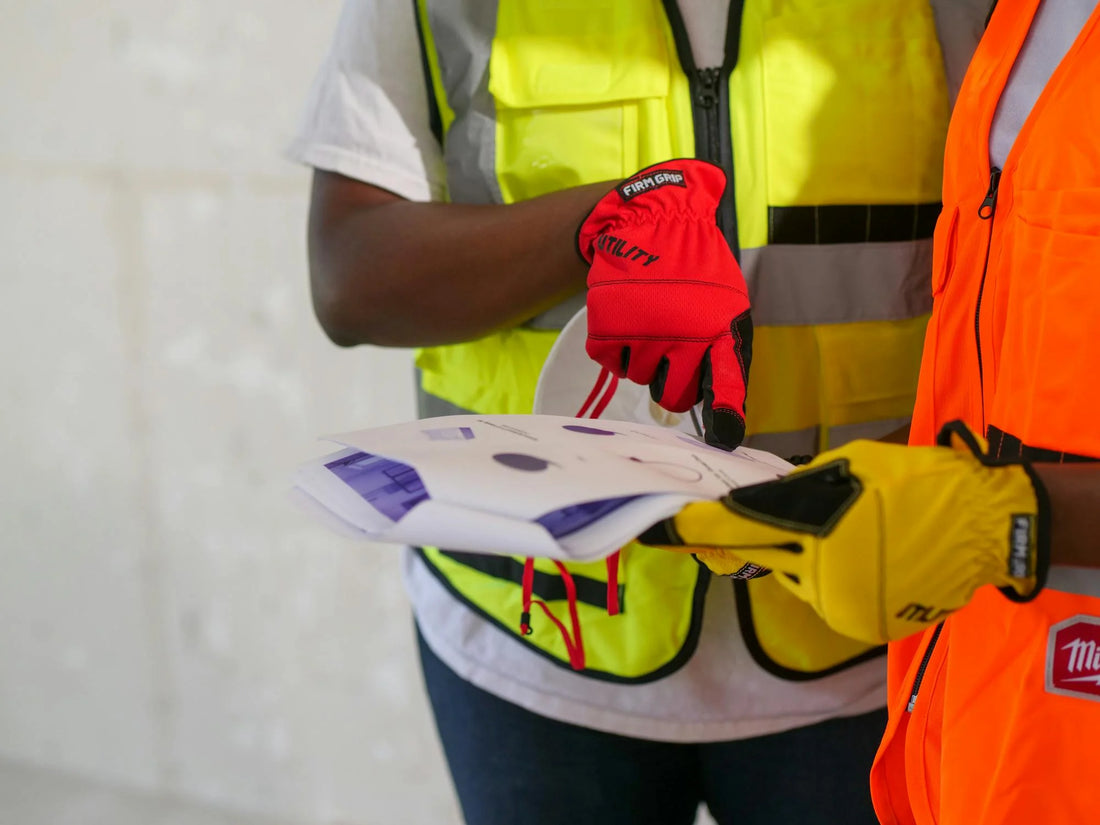
Why Industrial Safety Gear Is Essential for Your Workforce: A Comprehensive Guide to Protecting Your Most Valuable Asset
Why Industrial Safety Gear Is Essential for Your Workforce: A Comprehensive Guide to Protecting Your Most Valuable Asset
In the fast-paced and often demanding world of industrial operations, safety should never be an afterthought. It's not just a matter of compliance, but a fundamental responsibility to safeguard your most valuable asset: your workforce. The human element is at the heart of every successful business, and ensuring their well-being is paramount. This is where industrial safety gear steps in, playing a critical role in protecting workers from potential hazards and minimizing the risk of injuries.
Beyond Compliance: A Culture of Safety
While regulations and industry standards mandate the use of safety gear, it's crucial to go beyond mere compliance and foster a genuine culture of safety within your workplace. This means integrating safety practices into every aspect of your operations, from daily routines to emergency protocols. A culture of safety starts with leadership: demonstrating a genuine commitment to worker well-being through investment in the right equipment and robust training programs. It's about creating an environment where workers feel empowered to speak up about safety concerns without fear of reprisal, where safety is not seenas an inconvenience, but as a fundamental part of every job.
The Vital Role of Industrial Safety Gear
Industrial safety gear acts as the first line of defense against a wide range of potential hazards. From the harsh elements of outdoor work to the intricate machinery and materials handled indoors, each industry presents its own set of unique risks. This is where specialized safety gear comes into play, providing targeted protection to specific body parts and against specific hazards.
For example, the 100% Kevlar® Knit with PVC Dots gloves are designed to provide outstanding cut resistance, grip, and durability for tough, demanding work environments. These gloves are constructed entirely from Kevlar®, a fiber renowned for its exceptional strength and heat resistance. This makes them ideal for industries like manufacturing, automotive, and construction, where workers handle sharp edges, abrasive materials, and potentially hot surfaces.

The PVC dots on the palms and fingers of these gloves enhance grip, allowing for secure handling of tools and materials, even in oily or wet conditions. This added grip is crucial for tasks that require precision and control, reducing the risk of slippage and accidents. Despite their rugged design, these gloves are lightweight and comfortable, ensuring minimal hand fatigue during extended wear. They are a smart investment for any workplace where cut resistance, grip, and comfort are essential.
Beyond Protecting Individuals: The Business Impact
Investing in industrial safety gear is not just about protecting individual workers; it's a strategic business decision with far-reaching benefits. When you prioritize worker safety, you are investing in a more productive, efficient, and ultimately, more profitable operation. Here's how:
- Reduced Workplace Accidents: Accidents are costly, leading to downtime, medical expenses, potential legal liabilities, and a significant impact on employee morale. Adequate safety gear significantly minimizes the risk of accidents, translating into a safer and more stable work environment.
- Enhanced Productivity: When workers feel safe and confident in their equipment, their focus shifts from worrying about potential hazards to performing their tasks effectively. This boost in morale and confidence contributes to higher productivity levels, leading to better output and meeting deadlines more efficiently.
- Improved Employee Retention: Employees value employers who prioritize their safety and well-being. By demonstrating this commitment through investment in safety gear and programs, you create a more attractive workplace environment, leading to higher retention rates, reduced hiring costs, and a more stable workforce.
- Enhanced Reputation: A commitment to safety enhances your company's reputation within the industry, attracting talent and customers who value ethical and responsible business practices. A strong safety record can differentiate your company from competitors and build trust with stakeholders.
- Reduced Insurance Premiums: Companies with a strong safety record and a demonstrable commitment to worker safety often qualify for reduced insurance premiums. This financial benefit can further enhance your bottom line.
First Aid Preparedness: An Essential Component
While safety gear aims to prevent injuries, it is crucial to be prepared for unexpected incidents. Having a well-stocked first aid kit is essential for providing immediate care in emergencies, minimizing the severity of injuries, and ensuring prompt recovery.
The 195 Piece Soft First Aid Kit is a comprehensive and portable medical kit designed to address a wide range of minor injuries and emergencies. It's a must-have for any workplace, vehicle, or outdoor activity, providing peace of mind in case of unexpected accidents.

This kit includes 195 essential items carefully selected to handle cuts, scrapes, burns, sprains, and other common injuries, ensuring you have everything you need to treat minor wounds and provide first aid care. Crafted with a durable, soft-shell fabric, the case is lightweight yet sturdy, designed to withstand rugged conditions. Inside, the kit is well-organized with labeled compartments, making it easy to locate supplies quickly in an emergency. The kit also includes a first aid guide, offering instructions for handling various injuries confidently.
Choosing the Right Gear: A Tailored Approach
Not all safety gear is created equal. The right choice depends on the specific hazards present in your workplace and the tasks that employees perform. It is essential to conduct a thorough risk assessment to identify potential hazards and select the appropriate gear to address them effectively. This may include, but is not limited to:
- Head Protection: Hard hats, safety helmets, and ear protection are crucial for jobs involving overhead hazards, noise, and impact risks. These protect workers from falling objects, electrical hazards, and loud noises that can cause hearing damage.
- Eye and Face Protection: Safety glasses, goggles, face shields, and respirators provide vital protection against flying debris, chemicals, and dust. These ensure that workers' eyes and faces are shielded from potential injuries caused by particles, liquids, or fumes.
- Foot Protection: Safety boots and shoes with steel toe caps and puncture-resistant soles are essential for jobs involving heavy objects, sharp objects, and slippery surfaces. They protect feet from crushing injuries, punctures, and slips, providing stability and support on various terrains.
- Hand Protection: Gloves are critical for protecting hands from cuts, abrasions, chemicals, heat, and cold. Different types of gloves offer varying levels of protection, depending on the task and environment. For example, Kevlar® gloves are excellent for cut resistance, while chemical-resistant gloves protect hands from harsh substances.
- Body Protection: Protective clothing, such as overalls, aprons, and high-visibility vests, provide crucial protection against chemicals, heat, and impact hazards. These garments shield workers from spills, splashes, extreme temperatures, and visibility issues in hazardous environments.
- Respiratory Protection: Respirators are essential for jobs involving dust, fumes, and hazardous gases. They provide clean air to breathe, protecting workers from respiratory illnesses and long-term health issues.
Beyond Gear: Training and Education
Providing safety gear is only one part of the equation. It is equally crucial to invest in comprehensive training programs that educate employees on the proper use, care, and maintenance of safety equipment. Training should be tailored to specific job roles and hazards and should be regularly updated to reflect any changes in industry practices or regulations. This ensures that workers are equipped with the knowledge and skills to utilize safety gear effectively and to recognize and mitigate potential risks.
Effective training programs should include:
- Hazard Identification: Teaching workers to identify potential hazards in their work environment and to understand the associated risks.
- Proper Use of Safety Gear: Demonstrating the correct way to wear, adjust, and maintain each piece of safety gear, ensuring it provides maximum protection.
- Emergency Procedures: Training employees on emergency response procedures, including how to use first aid kits, how to call for help, and how to evacuate in case of a hazardous situation.
- Regular Reviews: Conducting regular safety audits and reviews to ensure that training is effective and that employees are adhering to safety protocols.
Creating a Culture of Safety: A Continuous Effort
Building a culture of safety is an ongoing process that requires constant effort and commitment. It's not just about implementing policies and procedures, but about fostering a mindset where safety is valued and prioritized by everyone. This can be achieved through:
- Open Communication: Encouraging workers to report any safety concerns without fear of repercussions. Creating a culture where feedback is valued and addressed proactively.
- Employee Involvement: Including workers in safety discussions and decision-making processes. This empowers employees and ensures that safety protocols are practical and relevant to their work.
- Positive Reinforcement: Recognizing and rewarding employees who demonstrate safe work practices. This encourages safe behavior and reinforces the importance of safety.
- Regular Safety Meetings: Holding regular safety meetings to discuss recent incidents, review safety protocols, and address any concerns or suggestions.
- Leadership by Example: Leaders at all levels should set a strong example by following safety protocols and promoting a safety-first mindset.
Conclusion: Investing in a Safer Future
Investing in industrial safety gear is a strategic business decision that pays dividends in the long run. By safeguarding your workforce, you are not only fulfilling your ethical responsibility but also creating a more productive, profitable, and sustainable business environment. Remember, a commitment to safety is not just about compliance; it's about building a culture of respect, responsibility, and a shared dedication to creating a safer future for your employees and your business.
